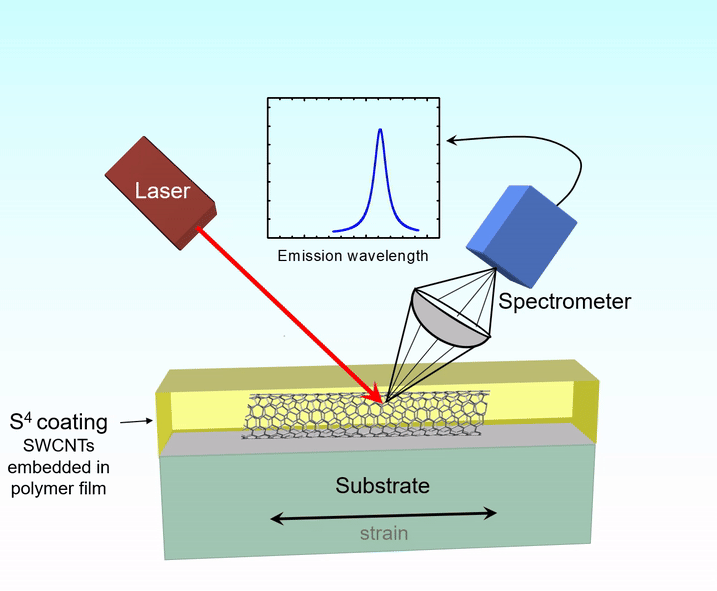Scheme for non-contact optical measurement
The basis of the S4 technology is that when a single-wall carbon nanotube (SWCNT) is strained by axial compression or stretching, its carbon atoms move more systematically and change the electronic band gap. This effect shifts the wavelength of the carbon nanotube's near-infrared emission peak by predictable amounts that are proportional to the strain along the nanotube axis. In this way, each nanotube can act as a tiny, optically monitored strain gauge. We dilutely disperse nanotubes in a polymer and air-brush onto the specimen to form a submicron thin sensing film that cures at ambient temperature. Subsequent strain in the structural member is transmitted through the film to those embedded SWCNTs, which then act as local strain sensors. To read out the strain values, we illuminate a region of interest with light from a red laser, capture the resulting near-infrared fluorescence, and spectrally analyze that fluorescence. Because the nanotube sensors are randomly distributed throughout the film, we can measure strain at all points of interest.
Relevant literatures
Next-generation 2D optical strain mapping with strain-sensing smart skin compared to digital image correlation, Wei Meng et al., Scientific Report (2022) 12:11226.
Noncontact strain mapping using laser-induced fluorescence from nanotube-based smart skin, Peng Sun et al., J. Struct. Eng. (2019) 145: 04018238.
Toward practical non-contact optical strain sensing using single-walled carbon nanotubes, Peng Sun et al., ECS Journal of Solid State and Technology (2016) 5(8).
Strain paint: noncontact strain measurement using single-walled carbon nanotube composite coatings, Paul A. Withey et al., Nano Letters (2012) 12: 3497.
Strain measurements on individual single-walled carbon nanotubes in a polymer host: structure-dependent spectral shifts and load transfer, Tonya K. Leeuw et al., Nano Letters (2008) 8(3): 826.
Carbon nanotube film sensors, Zhiling Li et al., Advanced Materials (2004) 16(7): 640.
Nanotube film based on single-wall carbon nanotubes for strain sensing, Prasad Dharap et al., Nanotechnology (2004) 15: 379.
Dependence of optical transition energies on structure for single-walled carbon nanotubes in aqueous suspension: an empirical kataura plot, R. Bruce Weisman and Sergei M. Bachilo, Nano Letters (2003) 3(9): 1235.
Band gap fluorescence from individual single-walled carbon nanotubes, Michael J. O’Connell et al., Science (2002) 297: 593.
Structure-assigned optical spectra of single-walled carbon nanotubes, Sergei M. Bachilo et al., Science (2002) 298: 2361.

